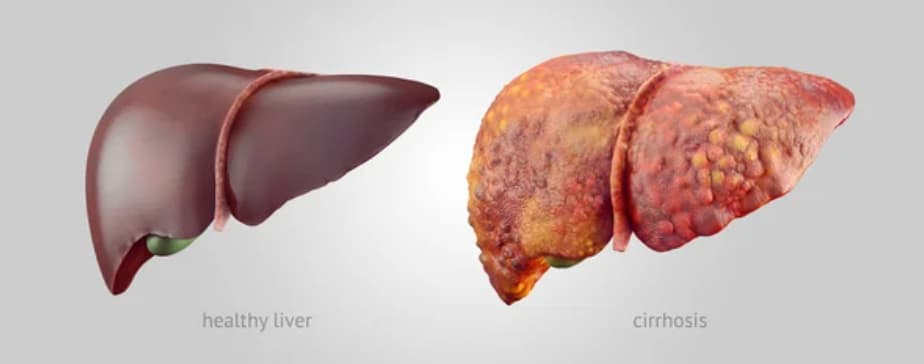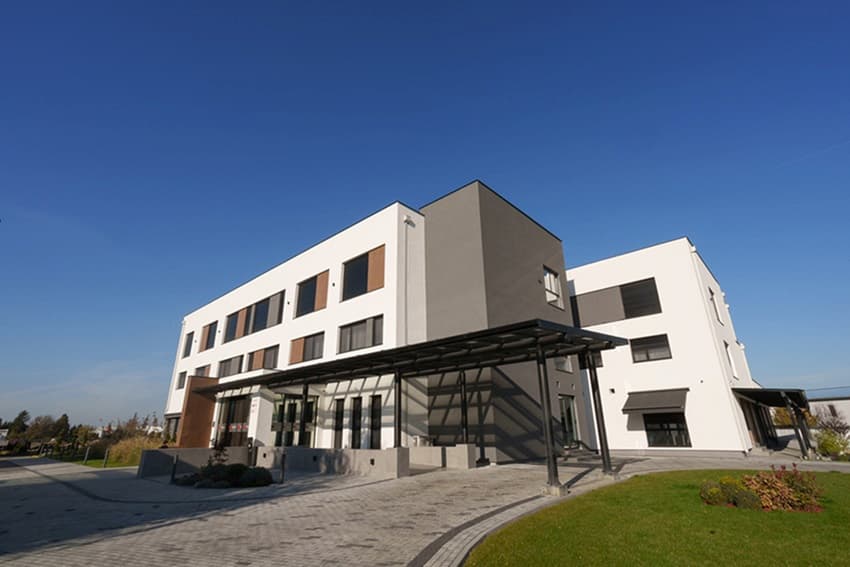Stem cell therapy for liver disease is a revolutionary approach that offers not just symptomatic relief, but also restores the organ’s function from within. Thanks to the unique ability of stem cell therapy for liver disease to stimulate regeneration and fight inflammation, this method opens doors for those who can no longer benefit from traditional treatments.
In this article, you will discover what stem cells are, how they work, and where you can receive this treatment.
How Liver Disease Develops and Why It’s So Dangerous
Almost all liver diseases arise from prolonged inflammation, as a result of which the functions of the organ are impaired and its structure begins to change.

The Liver’s Role in Your Health
The liver filters toxins, aids in digestion, regulates blood sugar, and produces clotting proteins—all of which are essential for maintaining homeostasis. Stem cell therapy for liver damage often targets these core functions to restore balance.
Common Types of Liver Disease
Liver diseases can have different etiologies. Some are caused by the consumption of alcohol or fatty foods. Others are caused by viruses or metabolic disorders.
When the liver struggles, toxins accumulate, metabolism slows, inflammation can get out of control, and it can lead to complications such as portal hypertension or hepatic encephalopathy.
The most common liver conditions and their causes include:
| Cirrhosis | Scarring from chronic inflammation and injury, often due to alcohol or hepatitis virus. |
| Fatty Liver Disease | Excess fat deposits, linked to obesity or diabetes. |
| Hepatitis | Infections from hepatitis B/C virus or autoimmune reactions. |
| Liver Failure | Sudden or gradual loss of function, requiring urgent care. |
When Liver Damage Becomes Irreversible
Chronic inflammation overwhelms the liver’s repair mechanisms and replaces functional tissue with scar tissue (fibrosis). At this stage, regeneration slows down, and stem cell therapy for liver damage becomes a potentially promising option for reducing inflammation and additional scarring.
Can Your Liver Heal Itself?
A healthy liver has the remarkable ability to regenerate itself. Even if it loses a significant portion—up to half due to damage—it can regain its mass to a level considered normal in relation to a person’s body weight.
The Liver’s Amazing Ability to Repair Itself
Healthy cells reproduce rapidly and often regain function within months, a process that is central to stem cell research for liver regeneration.
How Stem Cells May Promote Liver Healing
Stem cell therapy for the liver leverages the ability of stem cells to migrate to damaged areas, where they promote healing through various paracrine mechanisms.
| Reducing inflammation | Mesenchymal stem cells for liver regeneration have the ability to modulate the immune response, thereby reducing chronic inflammation. |
| Promoting regeneration | Stem cells release bioactive molecules that stimulate the formation of new blood vessels and activate the patient’s own stem cells. |
What Liver Conditions Might Benefit From Stem Cell Therapy?
Because of its unique capabilities, stem cell treatment for liver disease can be used in conjunction with conventional treatment for a variety of conditions.
Common stem cell types used in therapy:
| Adult stem cells | They are multipotent cells that can divide into a specific cell type, typically within a specific lineage. Examples include mesenchymal stem cells (MSCs), which are found in many types of tissues, and hematopoietic stem cells. |
| Induced pluripotent stem cells (iPSCs) | These are mature somatic cells that have been reprogrammed to behave like pluripotent embryonic stem cells. Derived from the patient’s own cells, they can self-renew and differentiate into any cell type in the body. At Swiss Medica we do not use them because they are not yet clinically proven. |
Stem Cells for Cirrhosis—Can They Reduce Liver Scarring?
A study of bone marrow stem cells for liver regeneration shows promise in early trials. MSCs appear to be:
The main advantage lies in the cell’s ability to produce many biologically active molecules, such as proteins, nucleic acids, and lipids, which are packaged in extracellular vesicles (EVs). These substances play a key role in tissue regeneration, reducing inflammation, and remodeling the extracellular matrix.
Mesenchymal stem cells for liver treatment effectively inhibit myofibroblast activity, which helps to reduce liver scarring. In addition, MSCs have immunomodulatory properties that promote a favorable environment for healing. Although the cells themselves may have limited survival after transplantation, their secretory activity continues to have therapeutic effects, making them particularly valuable in the treatment of fibrosis and cirrhosis.
Fatty Liver Disease and Stem Cells—A Possible Solution?
Non-alcoholic fatty liver disease (NAFLD) affects 32% globally. Stem cell therapy for liver damage in NAFLD focuses on improving insulin sensitivity and reducing oxidative stress.
Can Stem Cells Help With Hepatitis?
According to these studies, stem cell therapy in chronic liver disease such as hepatitis can improve organ function. This is achieved by the migration of cells to the damaged liver, where they help suppress inflammation and stimulate tissue regeneration.
Liver Failure—Can Stem Cells Offer a Second Chance?
A meta-analysis on stem cell therapy for liver failure evaluated different stem cell therapies, such as MSCs and hematopoietic stem cells for liver regeneration.
Mesenchymal stem cells show significant potential in the management. Combining stem cell therapy for liver failure with conventional medical treatment or plasmapheresis significantly improved patient survival and reduced the estimated severity scores for chronic liver failure. In particular, donor MSCs were more effective than autologous MSCs in improving patient survival.
Get a free online consultation
We’re always available online! If you’re ready to learn more and get answers about innovative treatments for liver disease, simply leave a request for a free consultation with our experts.

Medical Advisor, Swiss Medica doctor
How Can Stem Cells Be Used to Treat the Liver?
Swiss Medica prioritizes safety and personalized care at every stage of stem cell treatment for liver cirrhosis or other chronic liver conditions. This process is carefully designed to ensure optimal results. It combines cutting-edge science with a holistic approach to patient wellness.
Step 1—Assessing Your Liver Health
Stem cell treatment for liver damage starts with a free online consultation with a regenerative medicine specialist. The doctor will ask you about your medical history and advise you if stem cells for liver regeneration would be beneficial for you. A personalized treatment plan is then created.
Once the patient arrives at the clinic for treatment, the doctor may require additional evaluation methods, which may include:
- Blood tests
- Imaging tests such as ultrasound, CT or MRI
- Organ function tests
Step 2—How Stem Cells Are Delivered to Your Liver
Depending on the condition, the method of stem cell delivery may vary.
| Delivery method | Details |
| Intravenous injection | Stem cells for liver regeneration circulate via the bloodstream; an ideal method for widespread damage. |
| Portal vein injection | Direct delivery to the liver; requires imaging guidance. |
| Intrahepatic injection | Precise injection into damaged areas; used for localized scarring. |
Step 3—Recovery and What to Expect
During the initial two days after stem cell for liver treatment, rest and mild fatigue are common complaints.
In the first four weeks, energy levels and appetite improve gradually.
From the third to the sixth month, follow-up tests are performed to track changes in liver function.
Is Stem Cell Therapy Safe?
The procedure of stem cell therapy for the liver has been shown to have a favorable safety profile.
The side effects associated with this treatment are minimal and include only minor symptoms such as local discomfort at the injection site and a mild increase in body temperature.
What’s Next? The Future of Stem Cell Therapy in Chronic Liver Disease
Based on the recent advances in liver stem cell therapy, it is emerging as a promising approach to support liver regeneration and improve function. Researchers have found that mesenchymal stem cells play a crucial role in reducing fibrosis, modulating inflammation, and promoting repair of damaged liver tissue. Clinical trials have shown encouraging results, with up to 60% of patients experiencing improved liver function following MSC treatment for cirrhosis.
In addition, the application of induced pluripotent stem cells in liver diseases has shown potential in restoring healthy hepatocytes in cases of fatty liver disease. These findings highlight the growing potential of stem cells for liver regeneration as a viable option for patients seeking innovative solutions to liver disease
Choosing the Right Clinic for Stem Cell Therapy for Liver Conditions
Swiss Medica, located in Belgrade, Serbia, was founded in 2011 and has since become a leader in the field of regenerative medicine. The institution offers a more favorable environment for patients stays.
The medical professionals at Swiss Medica have obtained international qualifications, and the medical facility uses modern medical equipment and has its own laboratory. Mesenchymal stem cell therapy in Serbia offers a high-quality yet cost-effective alternative, with significantly lower costs than in Western Europe and the U.S.

How Much Does Stem Cell Therapy for Liver Disease Cost?
The cost of liver stem cell therapy varies based on factors such as location, clinic reputation, and the complexity of the procedure. On average, mesenchymal stem cell prices at Swiss Medica range from €7,000 to €31,000* for a full management course.
*The prices mentioned are indicative and subject to change based on individual factors, including the condition’s severity and the number of stem cells needed. Prices are valid as of January 2025.
Frequently Asked Questions About Stem Cell Therapy for Liver Disease
1. Can stem cells help with liver disease?
Yes, this therapy shows promising results. For example, stem cell therapy for liver cirrhosis improves the condition of the organ, its function, and the general health of the patient.
2. How soon will I see results?
Liver biomarkers in blood tests may improve within 4–12 weeks. Structural changes and reduction of scarring typically take 6–12 months.
3. Are the results permanent?
The results of therapy vary depending on the condition and its severity. Some patients may require additional sessions. Lifestyle changes, diet, and avoidance of alcohol are very important to improve results.
Contact us
Looking for personalized guidance on liver disease stem cell treatment options? Book a free consultation with our specialists today.

Medical Advisor, Swiss Medica doctor
List of References
Li TT, Wang ZR, Yao WQ, Linghu EQ, Wang FS, Shi L. Stem Cell Therapies for Chronic Liver Diseases: Progress and Challenges. Stem Cells Transl Med. 2022 Sep 21;11(9):900-911. doi: 10.1093/stcltm/szac053. PMID: 35993521; PMCID: PMC9492280. https://pmc.ncbi.nlm.nih.gov/articles/PMC9492280/?spm=2b75ac3d.69f85850.0.0.44a013859aNfUi
Liu, P., Mao, Y., Xie, Y. et al. Stem cells for treatment of liver fibrosis/cirrhosis: clinical progress and therapeutic potential. Stem Cell Res Ther 13, 356 (2022). https://doi.org/10.1186/s13287-022-03041-5 https://stemcellres.biomedcentral.com/articles/10.1186/s13287-022-03041-5#citeas
Teng ML, Ng CH, Huang DQ, Chan KE, Tan DJ, Lim WH, Yang JD, Tan E, Muthiah MD. Global incidence and prevalence of nonalcoholic fatty liver disease. Clin Mol Hepatol. 2023 Feb;29(Suppl):S32-S42. doi: 10.3350/cmh.2022.0365. Epub 2022 Dec 14. PMID: 36517002; PMCID: PMC10029957. https://pmc.ncbi.nlm.nih.gov/articles/PMC10029957/#:~:text=Nonalcoholic%20fatty%20liver%20disease%20
Cheng F, Huang Z, Wei W, Li Z. Mesenchymal Stem Cell Transplantation For Hepatitis B Virus-Related Acute-on-Chronic Liver Failure: A Systematic Review and Meta-Analysis. Curr Stem Cell Res Ther. 2023;18(6):834-842. doi: 10.2174/1574888X18666221214123844. PMID: 36518036. https://pubmed.ncbi.nlm.nih.gov/36518036/
Yang, X., Meng, Y., Han, Z. et al. Mesenchymal stem cell therapy for liver disease: full of chances and challenges. Cell Biosci 10, 123 (2020). https://doi.org/10.1186/s13578-020-00480-6 https://cellandbioscience.biomedcentral.com/articles/10.1186/s13578-020-00480-6#citeas
Hu, XH., Chen, L., Wu, H. et al. Cell therapy in end-stage liver disease: replace and remodel. Stem Cell Res Ther 14, 141 (2023). https://doi.org/10.1186/s13287-023-03370-z https://stemcellres.biomedcentral.com/articles/10.1186/s13287-023-03370-z#citeas
Medical Advisor, Swiss Medica doctor
Medical Advisor, Swiss Medica doctor






